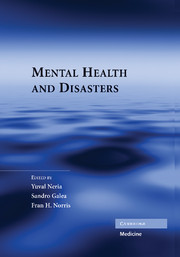Book contents
- Mental Health and Disasters
- Dedication
- Mental Health and Disasters
- Copyright page
- Contents
- Acknowledgments
- Contributors
- 1 Disaster Mental Health Research:
- Part One Concepts
- Part Two Psychopathology After Disasters
- 4 Anxiety Disorders And PTSD
- 5 Physical Health Problems after Disasters
- 6 Substance Use And Misuse After Disasters:
- 7 Depression and Prolonged Grief in the Wake of Disasters
- 8 What is Psychopathology after Disasters? Considerations about the Nature of the Psychological and Behavioral Consequences of Disasters
- Part Three Vulnerability And Resilience
- Part Four Special Groups
- Part Five Interventions And Health Services
- Part Six Case Studies
- Part Seven Questions and Directions
- Index
8 - What is Psychopathology after Disasters? Considerations about the Nature of the Psychological and Behavioral Consequences of Disasters
from Part Two - Psychopathology After Disasters
Published online by Cambridge University Press: 07 May 2010
- Mental Health and Disasters
- Dedication
- Mental Health and Disasters
- Copyright page
- Contents
- Acknowledgments
- Contributors
- 1 Disaster Mental Health Research:
- Part One Concepts
- Part Two Psychopathology After Disasters
- 4 Anxiety Disorders And PTSD
- 5 Physical Health Problems after Disasters
- 6 Substance Use And Misuse After Disasters:
- 7 Depression and Prolonged Grief in the Wake of Disasters
- 8 What is Psychopathology after Disasters? Considerations about the Nature of the Psychological and Behavioral Consequences of Disasters
- Part Three Vulnerability And Resilience
- Part Four Special Groups
- Part Five Interventions And Health Services
- Part Six Case Studies
- Part Seven Questions and Directions
- Index
Summary
- Type
- Chapter
- Information
- Mental Health and Disasters , pp. 131 - 142Publisher: Cambridge University PressPrint publication year: 2009
- 8
- Cited by



